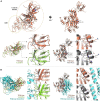Clinical and genetic analyses of premature mitochondrial encephalopathy with epilepsia partialis continua caused by novel biallelic NARS2 mutations
- PMID: 36620461
- PMCID: PMC9811187
- DOI: 10.3389/fnins.2022.1076183
Clinical and genetic analyses of premature mitochondrial encephalopathy with epilepsia partialis continua caused by novel biallelic NARS2 mutations
Abstract
Biallelic NARS2 mutations can cause various neurodegenerative diseases, leading to growth retardation, intractable epilepsy, and hearing loss in early infancy and further progressing to spastic paraplegia, neurodegeneration, and even death. NARS2 mutations are associated with mitochondrial dysfunction and cause combined oxidative phosphorylation deficiency 24 (COXPD24). Relatively few cases have been reported worldwide; therefore, the pathogenesis of COXPD24 is poorly understood. We studied two unrelated patients with COXPD24 with similar phenotypes who presented with intractable refractory epilepsia partialis continua, hearing loss, and growth retardation. One patient died from epilepsy. Three novel NARS2 variants (case 1: c.185T > C and c.251 + 2T > G; case 2: c.185T > C and c.509T > G) were detected with whole-exome sequencing. c.251 + 2T > G is located at the donor splicing site in the non-coding sequence of the gene. The minigene experiment further verified that c.251 + 2T > G caused variable splicing abnormalities and produced truncated proteins. Molecular dynamics studies showed that c.185T > C and c.509T > G reduced the binding free energy of the NARS2 protein dimer. The literature review revealed fewer than 30 NARS2 variants. These findings improved our understanding of the disease phenotype and the variation spectrum and revealed the potential pathogenic mechanism of non-coding sequence mutations in COXPD24.
Keywords: COXPD24; NARS2; aminoacylation reaction; gene testing; minigene; mitochondrial disease.
Copyright © 2022 Hu, Fang, Peng, Li, Guo, Tang, Yi, Liu, Qin, Wu and Ning.
Conflict of interest statement
The authors declare that the research was conducted in the absence of any commercial or financial relationships that could be construed as a potential conflict of interest.
Figures





Similar articles
-
Compound heterozygous variants of the NARS2 gene in siblings with refractory seizures: two case report and literature review.Front Pediatr. 2025 Apr 8;13:1571426. doi: 10.3389/fped.2025.1571426. eCollection 2025. Front Pediatr. 2025. PMID: 40264468 Free PMC article.
-
Novel NARS2 variants in a patient with early-onset status epilepticus: case study and literature review.BMC Pediatr. 2024 Feb 3;24(1):96. doi: 10.1186/s12887-024-04553-0. BMC Pediatr. 2024. PMID: 38310242 Free PMC article. Review.
-
Study of novel NARS2 variants in patient of combined oxidative phosphorylation deficiency 24.Transl Pediatr. 2022 Apr;11(4):448-457. doi: 10.21037/tp-21-570. Transl Pediatr. 2022. PMID: 35558980 Free PMC article.
-
Novel phenotype and genotype spectrum of NARS2 and literature review of previous mutations.Ir J Med Sci. 2022 Aug;191(4):1877-1890. doi: 10.1007/s11845-021-02736-7. Epub 2021 Aug 10. Ir J Med Sci. 2022. PMID: 34374940 Review.
-
Bilateral Nonsyndromic Sensorineural Hearing Loss Caused by a NARS2 Mutation.Cureus. 2022 Nov 14;14(11):e31467. doi: 10.7759/cureus.31467. eCollection 2022 Nov. Cureus. 2022. PMID: 36523694 Free PMC article.
Cited by
-
Compound heterozygous variants of the NARS2 gene in siblings with refractory seizures: two case report and literature review.Front Pediatr. 2025 Apr 8;13:1571426. doi: 10.3389/fped.2025.1571426. eCollection 2025. Front Pediatr. 2025. PMID: 40264468 Free PMC article.
-
Novel NARS2 variants in a patient with early-onset status epilepticus: case study and literature review.BMC Pediatr. 2024 Feb 3;24(1):96. doi: 10.1186/s12887-024-04553-0. BMC Pediatr. 2024. PMID: 38310242 Free PMC article. Review.
-
Progressive Mitochondrial Encephalopathy Due to the Novel Compound Heterozygous Variants c.182C>T and c.446A>AG in NARS2: A Case Report.Cureus. 2023 Aug 23;15(8):e43969. doi: 10.7759/cureus.43969. eCollection 2023 Aug. Cureus. 2023. PMID: 37746452 Free PMC article.
References
-
- Manole A., Efthymiou S., O’Connor E., Mendes M. I., Jennings M., Maroofian R., et al. (2020). De novo and bi-allelic pathogenic variants in NARS1 cause neurodevelopmental delay due to toxic gain-of-function and partial loss-of-function effects. Am. J. Hum. Genet. 107 311–324. 10.1016/j.ajhg.2020.06.016 - DOI - PMC - PubMed
LinkOut - more resources
Full Text Sources

